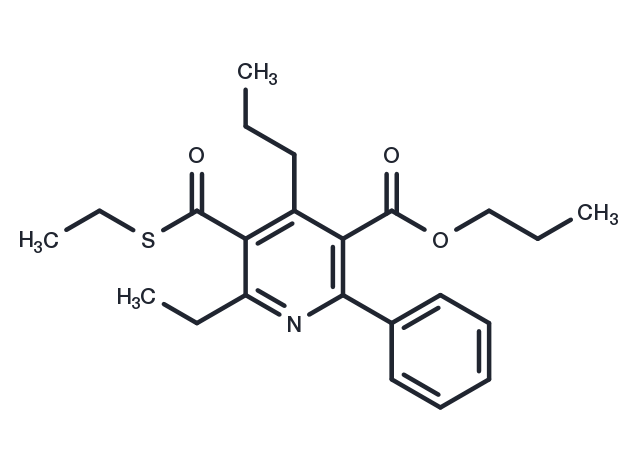Powder: -20°C for 3 years | In solvent: -80°C for 1 year


MRS 1523 can exert an antihyperalgesic effect through N-type Ca channel block and action potential inhibition in isolated rat dorsal root ganglion (DRG) neurons. MRS 1523 is an effective and selective adenosine A3 receptor antagonist Ki: 18.9 nM and 113 nM for human and rat A3 receptors, respectively). In rat this corresponds to selectivities of 140- and 18-fold vs A1 and A2A receptors, respectively.

| Pack Size | Availability | Price/USD | Quantity |
|---|---|---|---|
| 1 mg | 35 days | $ 140.00 | |
| 5 mg | 35 days | $ 470.00 |
| Description | MRS 1523 can exert an antihyperalgesic effect through N-type Ca channel block and action potential inhibition in isolated rat dorsal root ganglion (DRG) neurons. MRS 1523 is an effective and selective adenosine A3 receptor antagonist Ki: 18.9 nM and 113 nM for human and rat A3 receptors, respectively). In rat this corresponds to selectivities of 140- and 18-fold vs A1 and A2A receptors, respectively. |
| Targets&IC50 | A3 receptor (rat):113 nM(ki), A1 receptor:15.6 μM(ki), A2A receptor:2.05 μM, A3 receptor (human):(ki)18.9 nM |
| In vitro | NECA-induced migration is blocked in dose-response fashion by MRS 1523 with calculated Ki of 147 nM[4]. When human endothelial progenitor cells (hEPC) are co-incubated with MRS 1523 (1 nM), a partial blockade of the adenosine-5'-N-ethylcarboxamide (NECA)-induced migration is observed. Furthermore, in 3-days hEPC, the treatment with MRS 1523 100 nM inhibits the NECA-induced migration by 70%. MRS 1523 (0.1-1 μM) treatment obviously antagonizes cell numbers to 40.7% and 57.4% of the control values, respectively, 30 min before the addition of cordycepin (60 μM). MRS1523 (1 μM) alone has any effect on tumor cell growth[3]. |
| In vivo | Current-clamp recordings demonstrated that neuronal firing of rat DRG neurons was also significantly reduced by A3AR activation in a MRS 1523-sensitive but PD173212-insensitive manner. The endogenous agonist adenosine reduces N-type Ca currents, and its effect is inhibited by 56% in the presence of A3AR antagonist MRS 1523 [2]. |
| Molecular Weight | 399.55 |
| Formula | C23H29NO3S |
| CAS No. | 212329-37-8 |
Powder: -20°C for 3 years | In solvent: -80°C for 1 year
You can also refer to dose conversion for different animals. More
bottom
Please see Inhibitor Handling Instructions for more frequently ask questions. Topics include: how to prepare stock solutions, how to store products, and cautions on cell-based assays & animal experiments, etc.
MRS 1523 212329-37-8 Others MRS-1523 MRS1523 inhibitor inhibit
